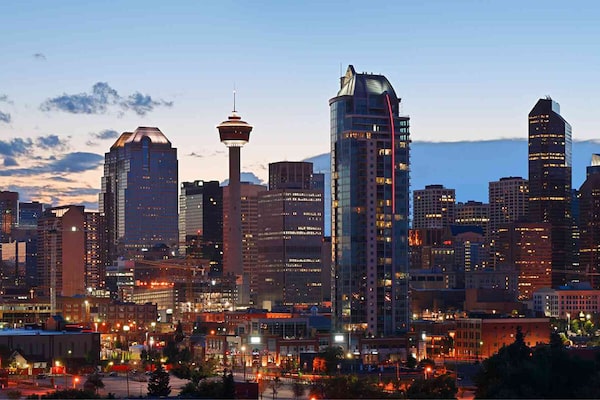
The sun sets behind downtown Calgary.Supplied
Seeking to implement bespoke regulations to short-term rentals (STRs), Calgary could be contravening its own climate strategy.
After a stint working in central Alberta, Elaine Pauls returned to Calgary in November, but she’s been unable to find a suitable rental in her hometown’s tight market – despite having a reasonably ample budget.
“Because I’m living with my parents, I’m kind of waiting to see if the market’s going to level out in the next year,” Ms. Paul says. “I’m not in a total place of desperation at this point, so that’s partially why I’m waiting to find the right place.”
The right place is a rental that allows pets, located in a neighbourhood where she can easily access services and amenities on foot.
“I’ve been searching for about two months,” Ms. Pauls says, pointing at the challenges she’s experienced so far, including fierce competition for the small number of listings available in walkable, central neighbourhoods such as Bridgeland, Crescent Heights, Altadore and Bankview. “I just would like to be able to walk to a grocery store in five minutes.”
According to an ongoing study undertaken by researchers at the University of Calgary in collaboration with the City of Calgary, the neighbourhoods that suit Ms. Paul’s car-light lifestyle, are also the areas where short-term rentals tend to concentrate.
More than 50 per cent of all units used exclusively as an STR in Calgary are located in the city’s centre, an October report found, following a pattern observed in other Canadian cities and across the globe.
If left unchecked, some worry this situation could be at odds with the goals of Calgary’s climate strategy, which aims to curb carbon emissions by increasing the number of residents in walkable neighbourhoods close to transit.
“To fulfill our Municipal Development Plan, as well as to be congruent with the climate strategy, having more population in established parts of the city is an important step,” says Noel Keough, an associate professor emeritus at the University of Calgary’s School of Architecture, Planning and Landscape, noting that the concentration of STR listings in these areas could challenge Calgary’s ability to meet its climate targets.
“The predominance of [STRs] in the city centre is problematic,” Prof. Keough says. “They’re using up some of the most valuable real estate in terms of proximity and services.”
In December, the number of long-term rental listings in Calgary’s centre was roughly 30 per cent smaller than the number of STR listings for entire units, according to AirDNA data. However, the role STRs play in limiting the options available to Calgary renters remains unclear.
Using a novel method, the University of Calgary study estimates that about 70 per cent of existing STR listings operate temporarily. That is, if renting them out short-term was not an option, most of the city’s active STR listings wouldn’t be incorporated into the long-term rental market – regardless of their characteristics or location.
The reason for this is that the frequency of some listings evidences patterns that could be related to the lifestyle of some Calgary homeowners, who choose to list their homes as a short-term rental while they travel for work or spend the winter months abroad.
“We estimate there are about 1,500 [dedicated] short-term rentals as of September of this year,” says Gillian Petit, a research associate at the University of Calgary’s School of Public Policy and co-author of the study.
Units used exclusively as a short-term rental for the better part of the year represent only 0.30 per cent of all dwellings in Calgary or the equivalent of 3 per cent of the rental market. (In October, 2022, Calgary’s vacancy rate was 2.6 per cent, according to CMHC data.)
“Calgary needs a lot more long-term rentals than that,” Ms. Petit says, adding that the consequences of the concentration of this type of listings in the city centre will be identified in the third phase of the study.
“Our next report is going to look at very specific community impacts for city centre,” she says. “Especially at how [STRs are] affecting long-term rental rates, housing choice, and vacancy rates.”
Like all good things, identifying the localized impacts of STRs in Calgary will take time.
When the final report of this study is presented in December, 2024, its findings will be used to inform the creation of evidence-based policies tailored to address Calgary’s specific needs and challenges, says Ward 8 Councillor Courtney Walcott.
“Some of the biggest challenges that we get into is we will see problems with short-term rentals at an international scale, which results in policy solutions that kind of get blanketed over several cities,” he says, adding that “Calgary has its own context to build a Calgary policy.”
An updated regulatory framework for a city that remains one of the least regulated STR markets in Canada should consider a wide range of issues and stakeholders, including Calgary’s 3,034 hosts, Ms. Petit notes. “Short-term rentals are also people’s livelihoods.”
In July alone, STR revenue added up to $22.1-million, and nearly 20 per cent of this was earned by a small number of property managers – a situation that Prof. Keough finds concerning.
“Part of the rationale of Airbnb is to allow people who wouldn’t be able to own a home to have a mortgage helper,” he says. “If you’re professionalizing, that diminishes the argument. These are not people who need to boost their income; these are business people capitalizing on housing assets.”